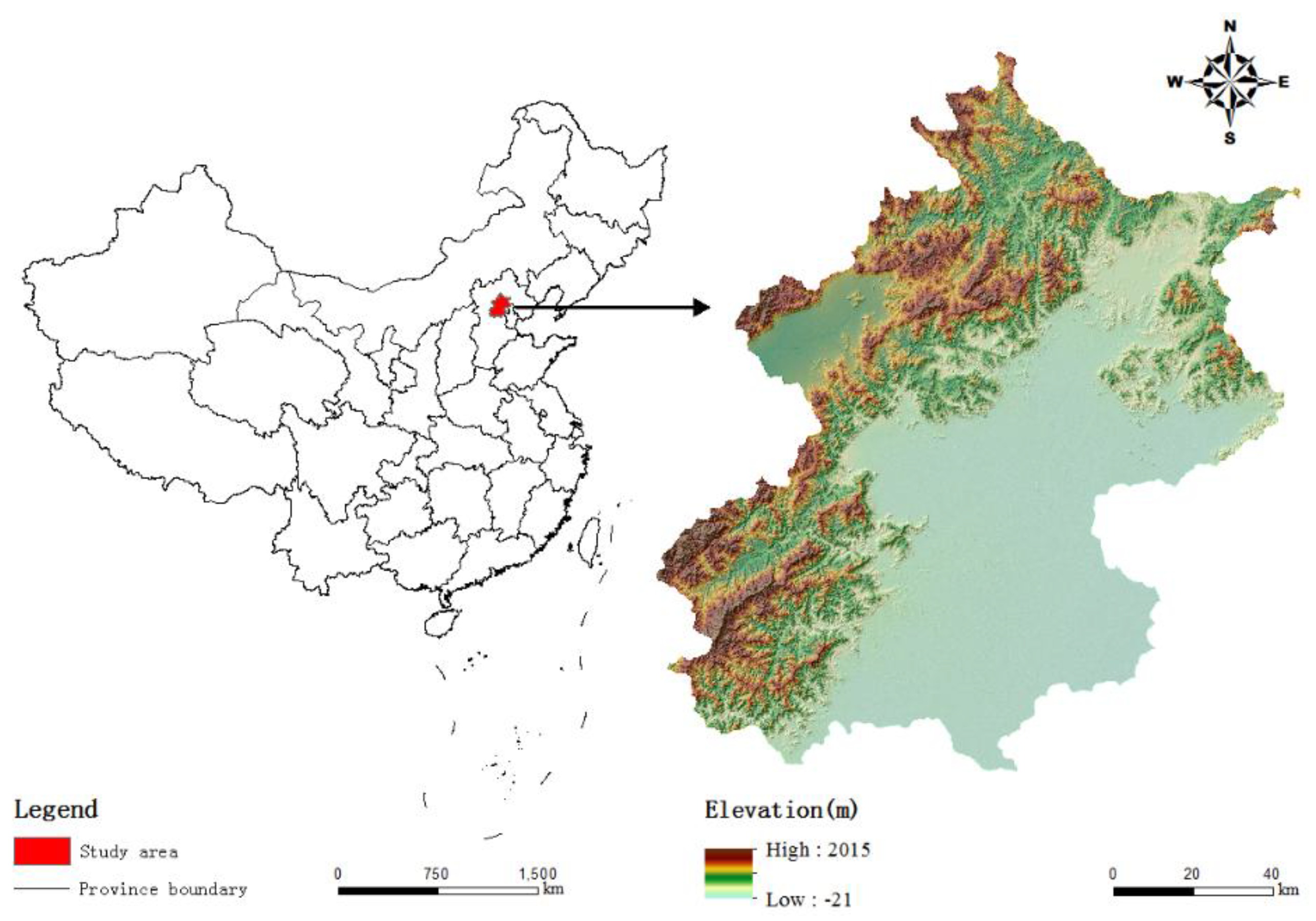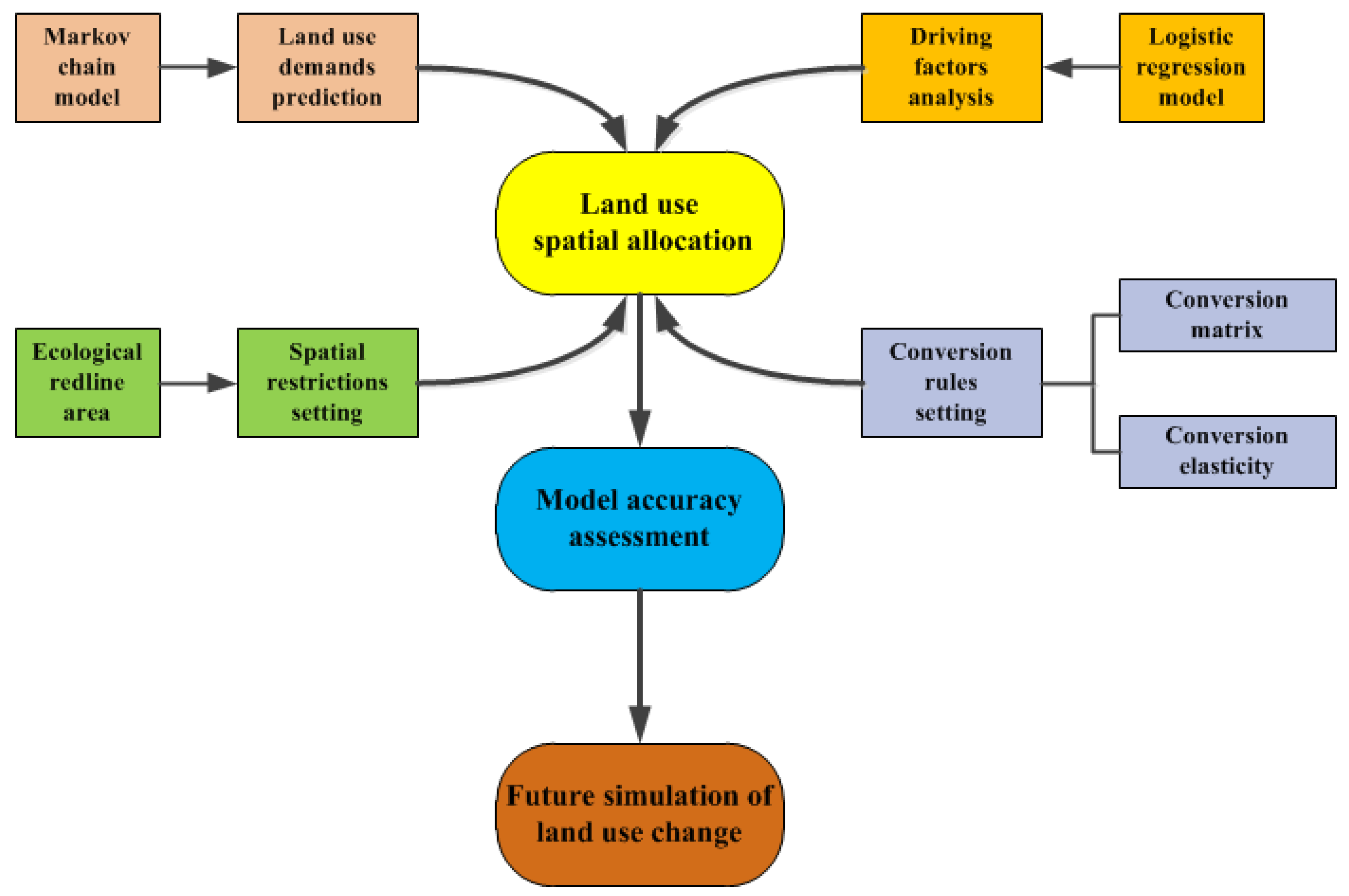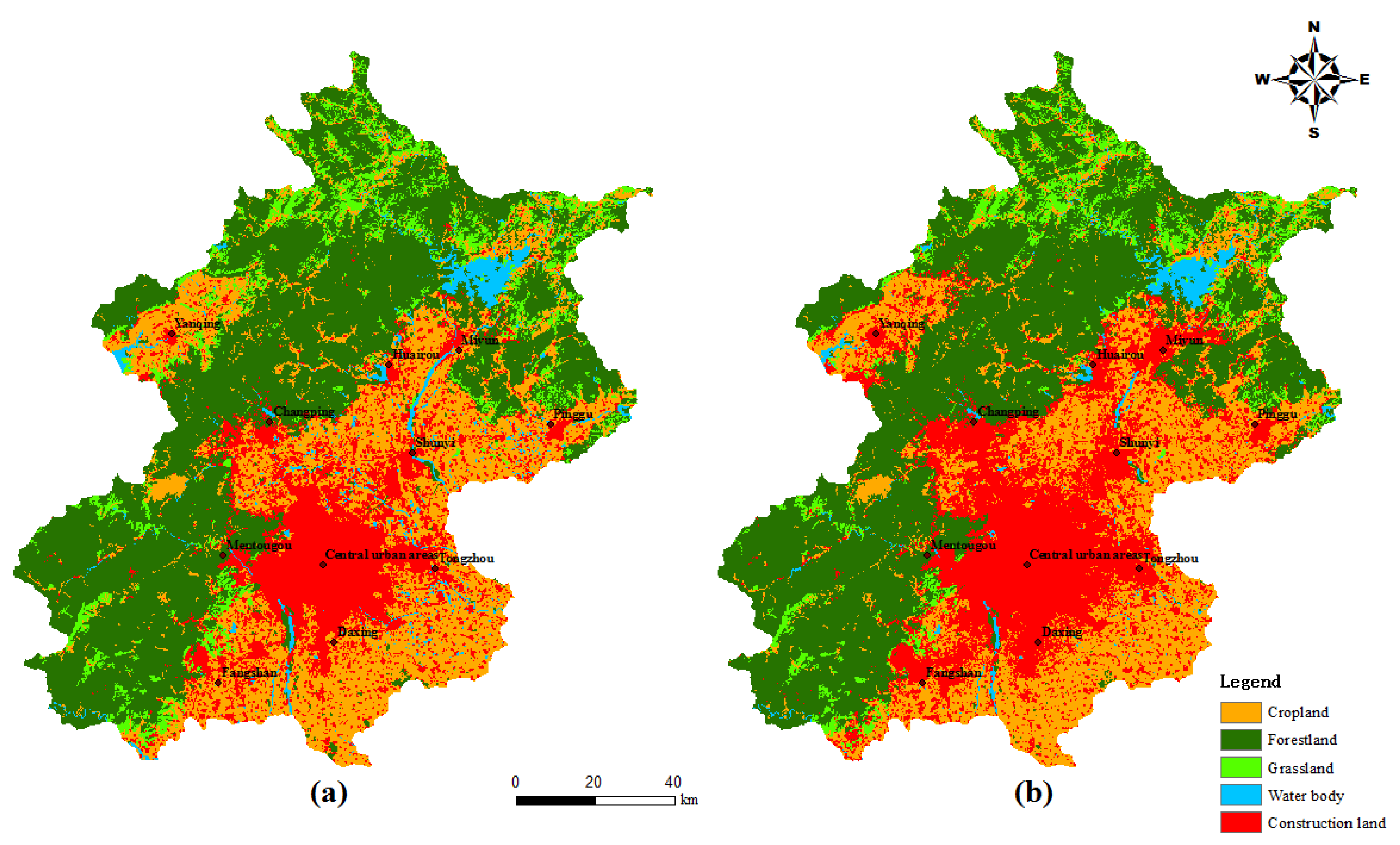1. Introduction
Land-use and land-cover change (LUCC) is considered one of the most profound terrestrial surface changes induced by human activities [
1,
2]. LUCC emerges from the dynamic interactions between natural and socioeconomic systems, which is identified as a core research field of the studies related to global environmental change [
3,
4]. Land-use activities caused by needs of development and construction are changing the function and structure of land systems [
5]. In urban areas, the conversions from non-construction lands to construction lands represent the most major process and critical form of LUCC [
6,
7,
8,
9], which has inevitably brought about negative effects on the landscape pattern and ecological system and put enormous pressure on natural resources and biodiversity [
10,
11].
With the acceleration of urbanization in China, the acquisition of construction lands for immediate development needs is generally achieved at the expense of degradation of ecological conditions. Frequent and intensive land-use activities have far-reaching consequences for local ecosystems. Reconciling conflicts between ecological conservation and urban development are one of the most formidable challenges encountered in the rapidly developing megacities such as Beijing [
12,
13,
14]. Following this, the concept of ecological redline was first put forward in China during 2011 and was written into Chinese environment protection law in 2014. The implementation of ecological redline policy has been raised to the national strategic level. Ecological redline, recognized as the baseline area of eco-environment system, can provide essential services for the guarantee and maintenance of eco-security and living environment safety [
15]. This policy sets rigorous targets for LUCC, which includes that the area cannot be decreased, function cannot be reduced and nature cannot be changed in ecological redline areas. It helps decision-makers to further fill the knowledge gap of “where there can be an orderly development and where there must be strict protection.”
Currently, local and international researchers have carried out related research studies to analyze driving forces and the underlying mechanisms of LUCC [
16,
17]. Different qualitative and quantitative methods were used to detect the drivers of LUCC [
18]. The driving forces of LUCC could be summarized into geographical and socio-economic factors. The former often refers to altitude, slope, aspect and distance to settlements, roads, rails, rivers and green lands; the latter mainly comprises of a city’s GDP, population growth and density. These factors affect land use changes directly or indirectly with high confidence levels [
19,
20,
21,
22,
23]. Most of existing studies have focused on the response of LUCC to geographical, social and economic drivers, which can provide a reliable reference for simulation of LUCC. Changes in landscape patterns resulting from the usage of land for diverse activities could be a potential reason for non-constructive land fragmentation [
24]. The abundance and variety of patch types are the greatest threats to the integrity of lands with ecological functions as well as to the creation of potential conditions for the conversion from non-constructive lands to constructive lands [
25,
26]. Therefore, ignoring the impacts of landscape pattern dynamics arguably conceals several inherent characteristics of LUCC in spatial distributions. Ecological redline aims to protect the important eco-fragile hotspots and eco-functional areas. It attempts to select the ecosystem services as a way to restrict unreasonable land-use activities compared to the existing restricted areas such as nature reserves, scenic resorts and wetlands. Few studies have been found in the literature that take into account the ecological redline as spatial restriction due to the novelty of the proposed policy. Therefore, it is well worth simulating the land-use changes restricted through ecological redline, which is expected to provide a comprehensive understanding of LUCC.
A variety of models have been widely introduced and exploited to simulate land use changes, such as cellular automata (CA) [
27,
28], agent-based modeling (ABM) [
11] and conversion of land use and its effects modelling (CLUE) [
29]. As a tool to simulate the spatio-temporal dynamics of complex systems, the CA model has been extensively used in the study of land use change and urban growth [
30]. CA models are not determined by strictly-defined physical and mathematical equations or functions and thus they are simpler and more flexible in their simulation of LUCC. Given the spatial and temporal complexities of LUCC, it is not enough to simulate changes of land use by properly defining conversion rules in CA models. More and more researchers focus on introducing constraints and building models, for example the SLEUTH model developed based on the CA model, to simulate land use changes more realistically [
31,
32]. However, the CA model has worse performance in simulating multiple land use changes. When different land uses are presented, the simulation involves more spatial variables and parameters and makes conversion rules and model structures more complicated [
33]. The process of LUCC is not only associated with natural constraints but also related to human drivers. In the context of ABM, diverse actions and decisions of human are incorporated into modeling of LUCC. The model provides a further understanding of the relationship between human drivers and causal mechanisms of LUCC. However, the main challenge of ABM is to clarify specific interactions between human actors and land systems, especially different response mechanisms and decision-making processes at various organizational levels. In the coupled human-environmental systems, the intrinsic complexity of interactions is so multifaceted that researchers have been exploring an effective approach to explicitly capture human behavior on LUCC [
11,
34]. The CLUE model was developed to simulate and predict the spatial changes in land-use pattern [
29,
35]. The CLUE-S version has been mainly used at smaller regional scale instead of larger national extent. It can quantitatively analyze spatial-temporal dynamics of multi-type land-use, particularly simulating possible land changes under a set of specified scenarios and considering driving forces, neighborhood elements and land suitability related to the designed scenarios. Because of its ease of implementation and its ability to simulate multiple land use changes combined with dynamic modelling of competition between different land types, the CLUE-S model has been widely applied in local and regional case studies with the spatial resolution varying from 20 to 1000 m [
36,
37,
38].
In this study, a CLUE-S model restricted by ecological redline is developed, which also takes into account the landscape metrics based on previous driving forces. The Kappa coefficient is introduced to evaluate the quality and to confirm the validation of the selected model as compared with the models with no restriction areas and traditional restriction areas such as nature reserves. We also apply the model to simulate spatio-temporal changes of land use in Beijing. The result can provide a scientific reference and strategic decision for promoting sustainable urban development.
4. Discussion
Simulation results confirm a trend that the overall change of land-use in Beijing over the period from 2010 to 2020 focuses on outward expansion around central urban areas, accompanied by the exurban sprawl distributed across multiple counties (
Figure 6). This dynamic reflects a spread of human settlements around the central city to the surrounding plains, while the diffusion in mountainous areas is relatively slower and to a much lesser extent. The process of this land-use conversion has been mainly achieved by encroaching on the croplands continuously. There has been a significant encroachment on the croplands and an obvious expansion of construction lands from 2010 to 2020 in the eastern and southern plain of Beijing. In 2010, people’s urban activities and behaviors were mainly concentrated in the central urban areas. In other districts and counties, there was a scattered distribution pattern that did not develop into a larger scale. By 2020, due to the never-ending expansion of the central urban area, the built-up area of the surrounding districts and counties will be expanding, which presents a tendency to gradually connect with the central area and become a spatial agglomeration entity of urban activities at a regional scale. In addition to the large encroachment of croplands, large quantities of grasslands have disappeared and been replaced by construction lands in the mountain towns of northwest Beijing and a significant shrinkage on water bodies occurs due to the rapid urbanization in the eastern and southern plain.
Disorderly spreading of urban space has not only destroyed abundant land resources but also easily triggered a series of problems such as traffic congestion, environmental pollution and population overcrowding. It does not keep in accordance with the goal of sustainable development. Conversely, the development mode of “satellite town” could effectively restrain the undesirable demands of urban sprawl. It depends on the prior urban development of downtown areas and still remains to be independent in order to alleviate the pressures on the population, transportation and industrial development in the central urban areas. According to the result of land use change in Beijing in 2020 simulated by CLUE-S, the decision-makers could take the following measures at the macro level: (1) Implementing stricter ecological redline policy to demarcate spatially explicit boundaries where there can be an orderly development and where there must be a strict protection (2) Encouraging the development and construction of satellite towns in case of overexpansion of downtown areas to ease the high pressures produced by urban sprawl (3) Implementing scientific spatial layout and rational planning of satellite towns to effectively prevent an excessive deterioration and fragmentation of natural landscapes and to restrain the transformation from basic farmlands into construction lands.
With the implementation of Beijing Urban Master Plan (2016–2035) approved by the State Council, Beijing will change the existing urban spatial structure characterized by the single center and focus on the space pattern of multi-center development. In addition, the new planning puts forward definite demands for setting and holding firm to ecological redline and forming a harmonious spatial pattern integrated with mountains, waters, forests, farmlands, lakes and the city in the overall layout. The simulation result, restricted by ecological redline, is most consistent with the actual change of land use from 2010 to 2015, which shows that ecological redline, defined as mandatory space constraint, has been considered in the actual activities of urban planning and management. The CLUE-S model based on ecological redline can simulate future land use changes in a more realistic situation and meet the requirements of the new Beijing Urban Master Plan. According to the simulation result, the obvious expansion trend of the construction land in Beijing’s suburban counties is influenced by the government’s policy of developing new towns, especially in the areas rarely restricted by ecological redline, such as Changping, Shunyi and Miyun. The function of the central urban area is gradually transferred to the suburban counties, which facilitates the formation of a polycentric development pattern. The construction of new towns is an important strategy to attract the population to concentrate in suburban counties and achieve the goal of the balance of population distributing required by Beijing Urban Master Plan.
The model developed in this study considers a comparatively comprehensive driving forces of land-use allocation, which include natural, locational, social, economic and landscape pattern attributes. Landscape pattern factors rarely expressed and described in previous models are considered and simulated in this model. The ecological redline, implemented as the strictest protection policy, sets rigorous requirements for land-use allocation and will play an increasingly important role in future land use changes. Ecological redline areas were restricted as areas with stable functions of land-cover in the simulation, which means that these specific lands in the particular regions were prohibited from all kinds of development and construction activities. The conceptual framework of the CLUE-S model, based on ecological redline restrictions and landscape driving factors, is capable of highlighting the space constraints with spatial integrity and connectivity and potential socio-ecological impacts of urban growth and encroachment on other types of land at the regional scale.
The proposed model can provide a tool for exploring the possible effects related to ecological redline policy and specific landscape pattern factors, which can be used to support further sustainable planning interventions. We believe that the proposed model should be systematically included in practices of spatial planning so as to foster sustainable development at the regional scale. Due to rapid economic growth and urban expansion, conflicts over land resources between humans and nature are continuously increasing [
49]. The disordered spatial development and irrational processes in urbanization destroy the essential land systems thereby affecting the local people at this stage and potentially might affect the next generation, which further brings a huge threat to the sustainable development of these regions. Therefore, correct and properly calibrated spatial planning is more necessary than ever; it is precisely through the reduction of soil loss, the protection of drinking water sources and other valuable ecosystems and the preservation of high quality areas for biodiversity and important natural landscapes, that the sustainable abilities can be increased and sustainability targets can be achieved [
31]. Additionally, this model also has the merit of having simulated spatially explicit distributions of multiple land use changes, which will be of value in future planning aimed at reducing the loss of non-construction lands for sustainable development in Beijing.
However, a major limitation of this model is the representation of causal mechanisms between driving factors and land-use and land-cover changes. In practice, due to the complexity of land use systems and the diversity of economically, socially and environmentally influencing factors, it is seemingly impossible to assess and analyze all the activities that determine LUCC. The limitation for availability of detailed data results in the lack of elaborate parameterization. In addition, the randomness and uncertainty generated by the limitation increase difficulties of excellent performance and credibility of the model. Therefore, there are several points that can be improved further. Firstly, it is necessary to further explore interactions of land use changes and landscape pattern changes in the model to further find out new driving factors. Secondly, more alternative scenarios should be taken into account, such as scenarios paying attention to economic development and scenario giving priority to environmental protection. Thirdly, the CLUE-S model should be coupled with other methods or models, such as the multi-agent system model, to further improve the accuracy and effectiveness of simulation and prediction.
5. Conclusions
This research featured an application of the CLUE-S model to simulate and analyze past and future land use changes in Beijing, China. We focused on the differences resulting from the application of contrasting scenarios based on spatial restrictions and driving factors. In this paper, on the basis of considering conventional natural and socio-economic indicators, the landscape pattern indicators were considered as new driving forces in the CLUE-S model to simulate spatial and temporal changes of land-use in Beijing. Compared with traditional spatial restrictions characterized by small and isolated areas, such as forest parks and natural reserves, the ecological redline areas increase the spatial integrity and connectivity of ecological and environmental functions at a regional scale, which were used to analyze distribution patterns and behaviors of land use conversion in the CLUE-S model. The validation results show that each simulation scenario has a precision of more than 0.76 and represents a high agreement between the actual map and the simulated result. The simulation scenario based on ecological redline restrictions and landscape driving factors has the highest Kappa coefficient with the value of about 0.7717. The simulation scenarios, including landscape pattern indicators, are more accurate than those without consideration of these new driving forces. The simulation results that use ecological redline areas as space constraints have the highest precision compared with the unrestricted and traditionally restricted scenarios. The CLUE-S model proposed in this paper has shown better effectiveness in simulating future land use change.
In order to simulate a more realistic changes of land use and support the policy decisions of urban development in Beijing, the CLUE-S model based on ecological redline restrictions and landscape driving factors was proposed to forecast and analyze the spatial and temporal dynamics of land at the regional scale. The overall change in Beijing’s land use during the period from 2010 to 2020 concentrates on city-centered outward expansion as well as the exurban sprawl distributed across multiple counties. This change describes an obvious spread of construction lands around the central urban areas to the surrounding plains, while human settlements in the hilly area are expanding at a relatively slower rate and to a much lesser extent. In terms of land-use structure change, land-use conversion mainly occurs between construction land and cropland. A large number of croplands are being converted to construction lands over the period from 2010 to 2020. Moreover, there has been a significant encroachment of grasslands in the mountain towns of northwest Beijing and large quantities of water bodies have disappeared and been replaced by construction lands due to rapid urbanization in the eastern and southern plains. To improve the sustainable use of land resources, it is necessary to adopt the construction and development mode of satellite towns rather than encouraging the disorderly expansion of central urban areas.










